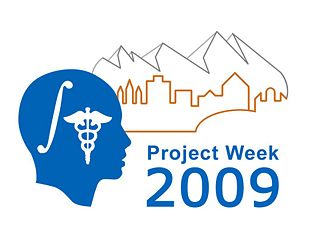2009 Winter Project Week fMRI Clustering
 Return to Project Week Main Page |
Key Investigators
- MIT: Archana Venkataraman
- BWH: Marek Kubicki
- MIT: Polina Golland
Objective
We are developing methods to characterize differences between healthy subjects and patients with Schizophrenia. Our work uses resting state fMRI data to pinpoint brain regions with "similar" voxel time courses. Resting state data is thought to capture spontaneous, low-frequency oscillations in the brain, and it is commonly used for functional connectivity analysis. The goal of this work is to pinpoint brain structures which are indicative of each population (healthy vs. Schizophrenic).
Approach, Plan
Our approach is to use clustering methods to partition the whole brain into functionally coherent regions. Currently, the most common approach for functional connectivity analysis is seed-based correlation analysis. This method requires the user to identify a "seed" region of interest and identifies voxels significantly correlated with the mean time course of this ROI. In contrast, clustering algorithms are entirely data-driven and do not require any prior information about the brain's spatial or functional organization.
We consider two different clustering algorithms: K-Means clustering and Spectral Clustering. To enable clustering of the entire brain volume, we use the Nystrom Method to approximate the necessary spectral decompositions.
Our plan for project week is to start pre-processing the new dataset of healthy subjects and schizophrenia patients using FSL. This includes standard fMRI preprocessing as well as additional preprocessing for functional connectivity analysis. If time permits, we would like to obtain preliminary clustering results and understand the strengths/limitations of the above clustering methods.
Progress
It has previously been shown that both K-Means clustering and Spectral Clustering produce reasonable partitions across subjects (A. Venkataraman et. al). However, the study was carried out on a dataset of 45 healthy young adults. These results have not been tested/compared across different populations.
Over this past week, we have successfully pre-processed an initial set of 12 subjects (4 healthy, 8 schizophrenia patients) using specialized functional connectivity analysis scripts. We have also obtained preliminary K-Means and Spectral Clustering results. We are able to see well-known structures within the brain, such as the default network. More importantly, we have identified new challenges in working with this new data. For example, since there is a greater variability among the schizophrenia subjects, it is no longer reasonable to represent the population based on the group clustering average. Therefore, we are seeking alternative models and a more intelligent feature space for working with resting state fMRI data. Hopefully, this new representation will give more consistent and meaningful partitions for individual subjects.
References
- A. Venkataraman et. al. "Exploring Functional Connectivity in fMRI via Clustering." Submitted to ICASSP 2009.
- M.D.Fox and M.E.Raichle, "Spontaneous Fluctuations in Brain Activity Observed with Functional Magnetic Resonance Imaging." Nature, vol.8, pp.700-711, 2007.
- B.Biswat et. al. "Functional Connectivity in the Motor Cortex of Resting Human Brain using Echo-Planar MRI." MRM, vol.34, pp.537-541, 1995.
- C.Fowlkes et. al. "Spectral Grouping Using the Nystrom Method." IEEE PAMI, vol.26, pp.214-225, 2004.
- P.Golland et. al. "Detection of Spatial Activation Patterns as Unsupervised Segmentation of fMRI Data." MICCAI, pp.110-118, 2007.